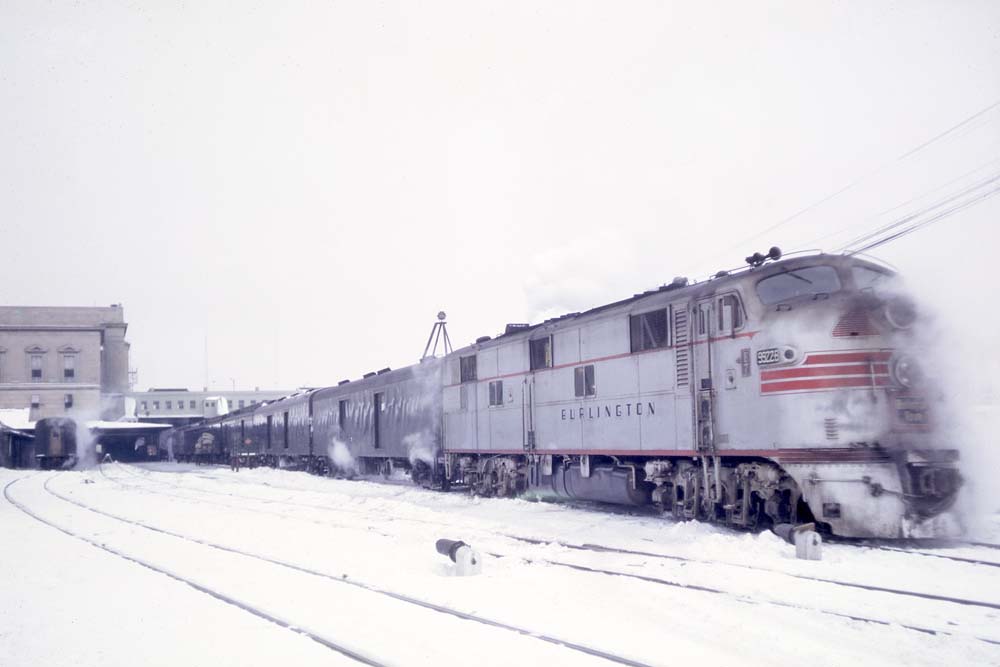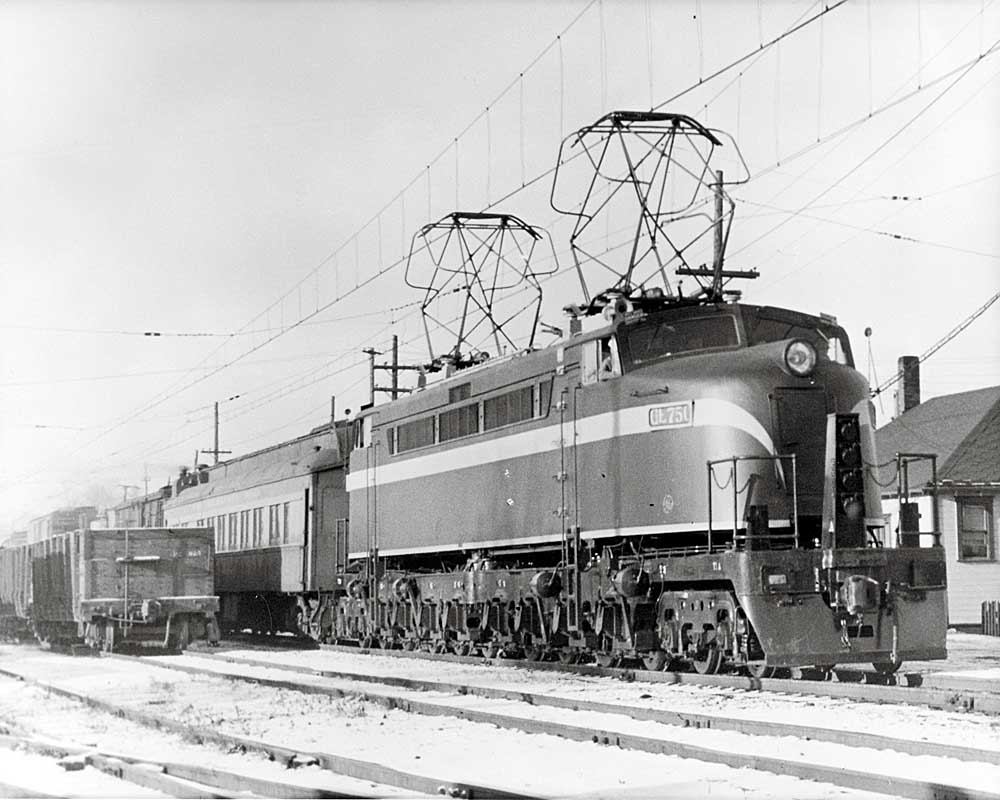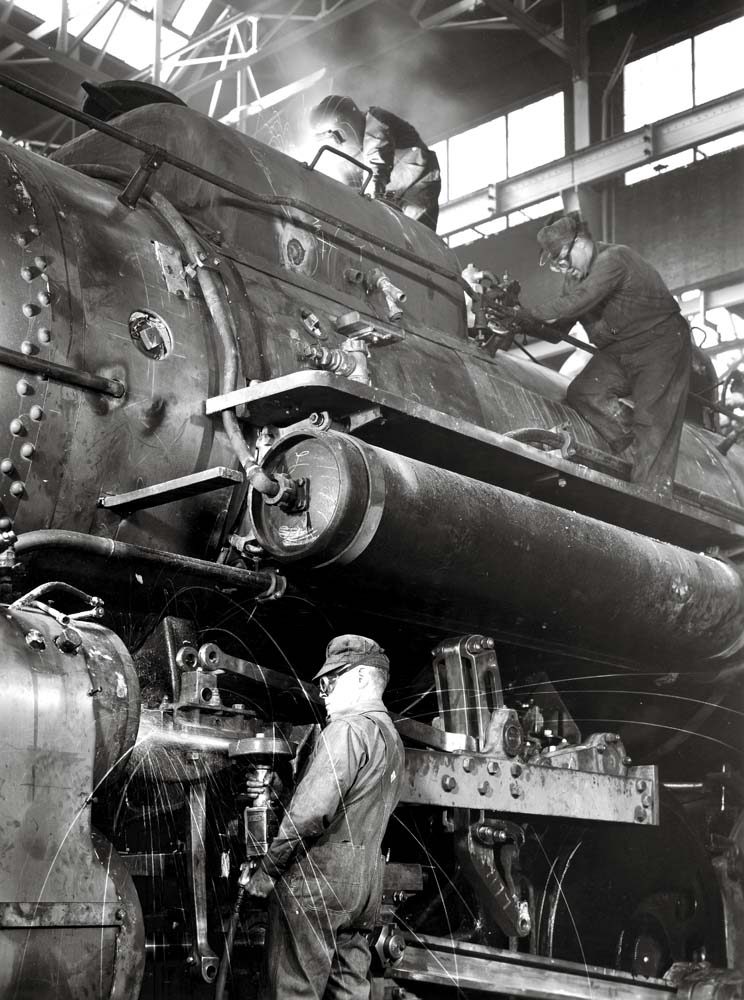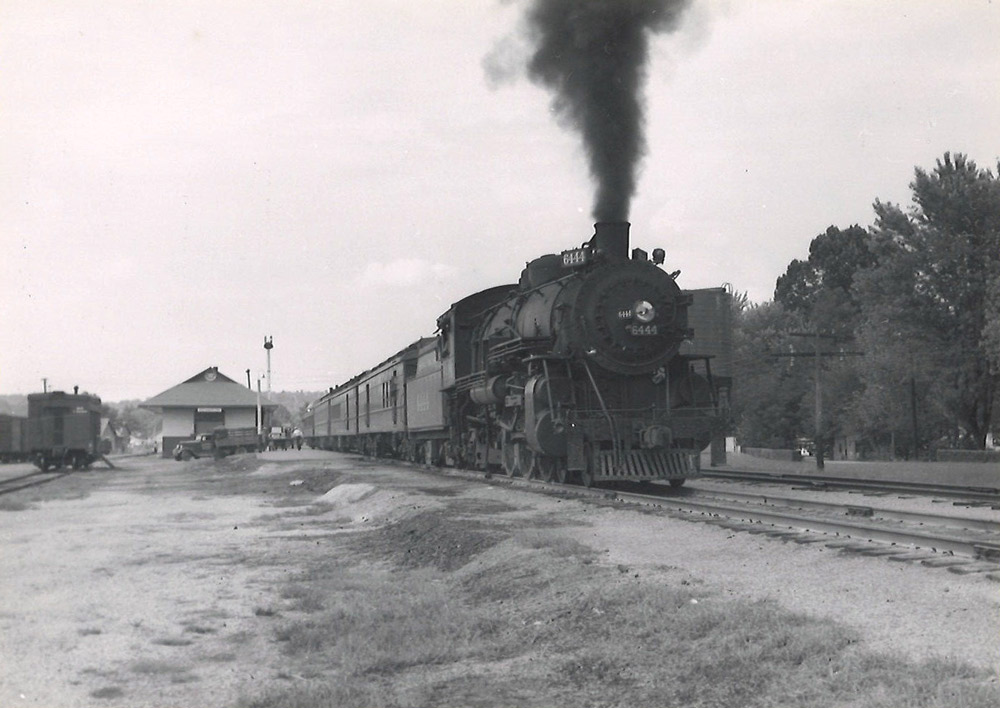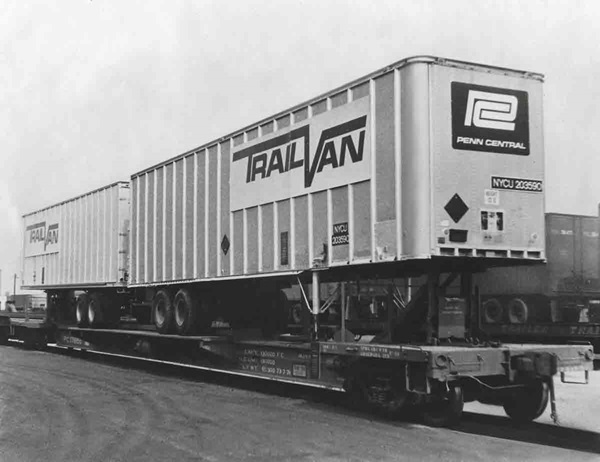
At the time of their merger in 1968, both the Pennsylvania and New York Central had extensive intermodal operations, with PRR using conventional Trailer Train cars in piggyback service and NYC using Flexi-Van equipment in an early form of containerized traffic. Penn Central retained both systems initially, but Flexi-Van traffic gradually declined.
By late 1970 the first Flexi-Van cars, which used hydraulic turntables to load and unload the containers and had high maintenance costs, had been taken out of service. It was decided to see whether these cars, which were structurally sound and potentially had many years of remaining life, could be converted for conventional trailer-on-flatcar (TOFC) service. I was Mechanical Engineer, Freight Car Design, for the PC at the time and was given the assignment of developing the design for the car modification. One prototype was to be modified and tested before deciding whether to proceed with conversion of the 400 or so available cars.
Having been established by the PRR in 1955, Trailer Train Co. had many former Pennsy employees, and its headquarters was just a few blocks from our office in Philadelphia. Classical music has its “Three B’s” — Bach, Beethoven, and Brahms — and so did the PRR mechanical engineering department in the 1950s: Bertram, Bugg, and Brodeur. In 1971 Roy Bertram had left the railroad, but Wayne Bugg was my boss and Rene Brodeur was Director, Engineering & Research, at Trailer Train. Although our project would take business away from Trailer Train if successful, Rene generously provided helpful information on TOFC cars.
By this time, many of PC’s intermodal terminals were equipped with straddle cranes or Piggy-Packers to lift trailers on and off the flatcars. The car therefore did not have to provide for circus loading, in which the trailers are driven on and off the car. This greatly simplified the modification, because cars equipped for circus loading must have continuous decks for the entire length of the car and have both trailer hitches facing the same direction, with one hitch at one end of the car and the other hitch in the center.
The Mark II Flexi-Van cars under consideration for conversion had long center sills consisting of twin wide-flange steel beams with short platforms at the ends (what would today be called “skeleton” or “spine” cars) and consequently would have required extensive modification for circus loading. Since the car needed to be capable only of overhead loading, I developed a design in which the trailers were placed back-to-back on the car with the hitches applied at the ends and a partial-length platform added at the center to support the tires. This trailer positioning had the benefit of preventing would-be thieves from opening the trailer doors and was later repeated in Trailer Train’s KTTX cars that had been modified to carry two 45-foot trailers on 89-foot cars.
One prototype car was converted in July 1971 at our shop (now Amtrak’s) in Beech Grove, Ind., near Indianapolis. The plan was to load the car with two empty trailers at Beech Grove, move it to Indianapolis Union Station on the local switch run, and have it picked up by a mail and express train from Cincinnati, which would haul it to Chicago. There the empty trailers would be replaced by loaded trailers, which would be hauled in a regular TOFC train as far as Collinwood Yard, east of Cleveland. The car was to be accompanied during the test by PC’s research car, which happened to be in Beech Grove at the time and was ready to be returned to the Research Department, whose headquarters were at Collinwood.
The car modification went well, thanks in part to help from Dick Yeates, ACF’s product engineer for trailer hitches. The trailers were loaded satisfactorily, and everything was going well as the switch run approached Indianapolis Union Station. It was intended that the switch engine would haul us through the platform tracks to the west end of the station where we would wait for the M&E train.
The brakeman and I were standing in the vestibule of the research car, looking forward. As we got closer to the platform sheds he asked me, “Are you sure those trailers will clear the platform roofs?” Within moments it became all too apparent that they would not. In all the effort to design the car modification and make sure it was applied satisfactorily, I had never checked to ensure that the route for the test runs would accept a car loaded with trailers that stood more than 16 feet 11 inches above the rail. By this time, the mail train was due in less than an hour.
The immediate problem of getting through the station was solved by running around the platforms on the freight bypass tracks to the south, and the two cars were soon spotted on the west side of the station. But what about the rest of the route from Indianapolis to Chicago and Collinwood? While the switch run was making the run-around move, I ran down the platform stairs into the station to find a company telephone. I called the Clearance Bureau in Philadelphia to explain our problem (my problem) and find out what lay ahead for us. I gave the person I was talking to the dimensions of the loaded TOFC car and the route we were planning to take. He quickly determined that the only clearance problem we would have for the entire trip was . . . the sheds at Indianapolis Union Station. I breathed a sigh of relief and rejoined the train.
The remainder of the trip went smoothly, with no clearance problems. Indeed, the only problem of any kind was a number of unintended emergency brake applications while running east from Chicago when the engineer made service applications. It turned out the air brake control valve on the research car was overly sensitive to service reductions and needed to be adjusted.
So, was the Flexi-Van car conversion successful? Yes and no. The modification itself worked perfectly well, and a photo of the car appeared in Railway Locomotives & Cars shortly afterwards. However, no more cars were modified. Although I don’t know the full story, I have always assumed the railroad was unable to come up with the necessary funds. This was about a year after the Penn Central bankruptcy and money was becoming increasingly tight. Financing was more readily available to lease new cars, which could be transferred to other users in case of default, than for modifications to existing cars that would be more difficult to place.
I left the railroad two years later to join Trailer Train (by then located in Chicago), working for Rene Brodeur. Upon arrival, I found that Dick Years had himself joined Trailer Train just the week before.
First published in Winter 2012 Classic Trains.






